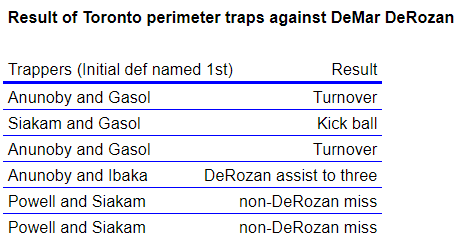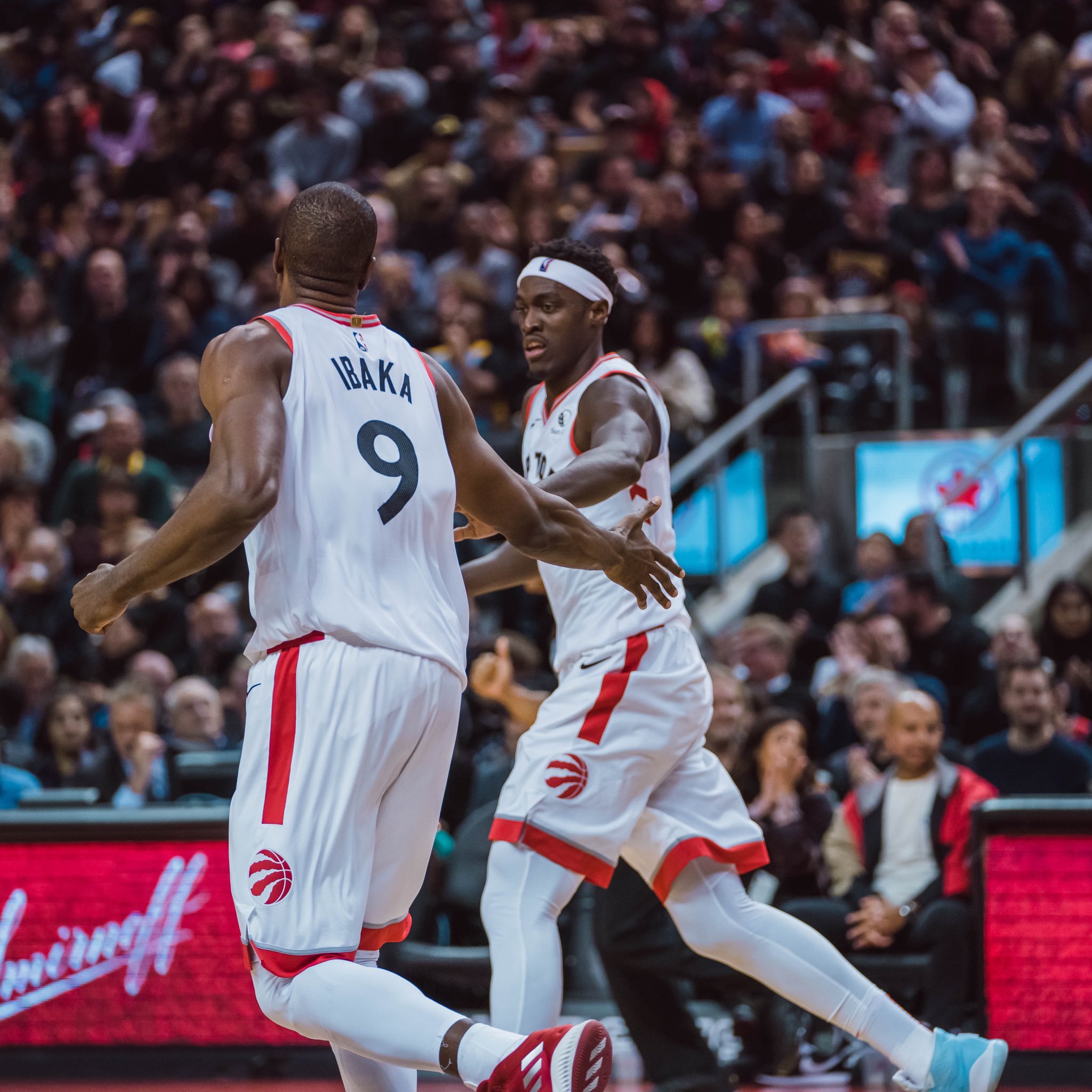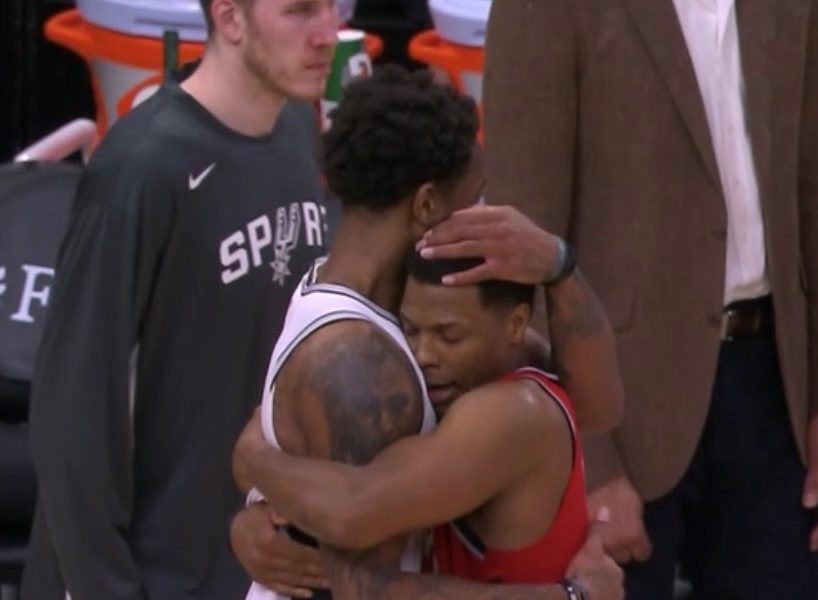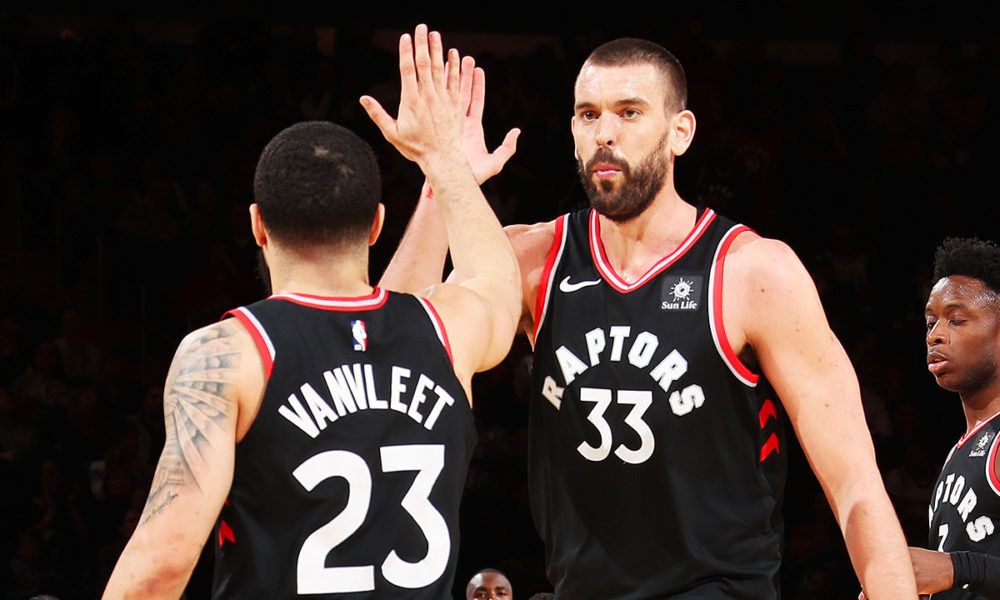It seems strange to talk about basketball a day after the tragic passing of Kobe Bryant. It felt strange to watch basketball yesterday, the earliest of the NBA’s slate of games beginning as details of the helicopter crash were still flooding into the public domain. It felt strange to see so many players and staff on both the Toronto Raptors and San Antonio Spurs grieving live on camera, from Bryant-disciple DeMar DeRozan to fellow Philadelphia native Kyle Lowry to longtime Bryant-antagonist Tim Duncan. But as the simple act of playing basketball was a salve for some of those in the NBA, perhaps understanding it too can be a salve for the NBA-viewing public. So let’s dig into some minutiae as a distraction.
The Raptors opened the 2019-20 season like the Yu Darvish of the NBA, with more off-speed defenses than any other team in the league, as capable of buckling knees with a zone as turning offenses inside-out with traps or doubles. Toronto used zones, to the surprise and occasional disdain of the NBA, throughout the 2018-19 playoffs en route to a championship, even unearthing the rarely seen box-and-one to keep Steph Curry and the Warriors off the scoreboard in the Finals. Traps, especially, became Toronto’s calling card early in this new season. Even if they didn’t always look great, and resulted in more corner threes for opponents than desirable, the Raptors found success by trapping opponents’ stars.
Then Nick Nurse and the Raptors took it perhaps too far during early December. Over the course of a three-game period against teams with plenty of ball-dominant stars in the Utah Jazz, Miami Heat, and Houston Rockets, the Raptors’ traps were dismantled by Jimmy Butler and then James Harden.
“We’ve been so good behind the double-teaming schemes, and then we weren’t the other night,” said Nurse after a loss to the Heat in which Butler collected 12 assists. “That’s one thing we talked about yesterday. We’ve been so good behind [the traps] getting it out of the primary guy’s hands and the other night we just were not. We weren’t protecting the rim well enough, we weren’t getting out to the shooters well enough, we weren’t chasing the misses well enough.”
“There’s pieces that need to be done. For us, they’re ball-pressure, they’re trying to contain the dribble, they’re contesting shots, and then obviously tagging and pursuing the rebound.”
Even when the Raptors’ traps weren’t working well, the team knew that the practice would be invaluable when the games mattered in the playoffs. Using strange schemes in the regular season is part and parcel of preparing for the post-season. Unfortunately, external factors limited Toronto’s ability to use those schemes towards the middle of December.
Coinciding with Toronto’s diminished success in trapping defenses was a rash of injuries. Over the course of December, the Raptors lost Pascal Siakam, Marc Gasol, Norman Powell, and Fred VanVleet to injury. Suddenly, Toronto’s ability to trap was limited by its player availability in each game. The Raptors no longer possessed the heady, dynamic defenders capable of playing in a variety of schemes. Toronto turned to a simpler, man-to-man defensive scheme for the majority of December and January.
To be fair, Toronto’s simplified defense was excellent; the team had the fourth-best defensive rating in the league from December 18, when Siakam, Gasol, and Powell were injured, to January 15, when Gasol returned. But the defense was one-dimensional. They no longer possessed the change-ups, sliders, and curveballs that could baffle even the best offenses.
Now that Toronto has returned to health, that limitation no longer remains. Against the San Antonio Spurs, the Raptors returned to their trapping roots as they faced the scoring maven DeMar DeRozan. The Raptors trapped DeRozan on the perimeter six times in the game, and those plays resulted in only three combined points allowed.

That’s a lot of success. Note that all of Toronto’s success came with one or both of Gasol and Siakam involved in the play, which serves as a small explanation for why the Raptors were forced away from trapping when the two were injured. Similarly, when the correct personnel wasn’t on the floor against San Antonio, the rotations behind the traps were too loose. Here, when the Raptors decided to trap Lonnie Walker IV, who is not the caliber of DeRozan, Toronto yielded an excellent shot at the back end of the play because of the loose trap and then the weak rotations behind that trap.
It takes a specific unit to employ a scheme that requires a variety of decisions in quick succession. That was proved against San Antonio, if it wasn’t already proved over the course of December and January.
When Toronto was active and aggressive, the Raptors saw results, multiple times creating turnovers because they complicated the floor, and the players rotating on defense just happened to be in the way of any and all passing lanes. These rotations are tight, with every man knowing exactly where he should be several steps ahead of the play. Look at the three not involved in the trap, Siakam, VanVleet, and Lowry. They rotate, tag, stunt, help, and take away the first and second option of each Spur who touches the ball. This is masterful.
Even when Toronto didn’t force turnovers, they were able to get the ball out of DeRozan’s hands. His teammates at the guard spots, are not nearly as capable at creating their own shots or creating for others. The results, multiple times, were poor shots choices that were heavily contested.
Partially as a result of the scheme, DeRozan was held to 14 points and only nine field goal attempts in the game. The traps forced the ball out of his hands, and only once were the Raptors burned with a made basket immediately following DeRozan’s pass out of the trap. More often, the traps worked.
The Raptors know they have a base defense that works. They employ so many plus defenders that a straightforward man-to-man will usually succeed against most opponents. But those teams that can score against such a defense are more common playoff opponents. Toronto needs to have zones and traps ready for the playoffs, if only to use once every ten possessions to alter the pace and flow of the game. And those off-speed plays are only viable when a few specific players, namely defense stars like Gasol, Anunoby, Siakam, VanVleet, or Lowry, are available.
Fortunately for Toronto, they now have those players back on the floor and thriving. The team no longer has to throw fastball after fastball over the plate. Toronto has its nastiest pitches back in the bag, and it employed them well against the Spurs. Those pitches may well be holstered in coming weeks, or they may be unveiled against a variety of opponents.
To be frank, none of this matters right now. In the wake of Kobe Bryant’s death, the players on the floor were disinterested in the game itself, the collision of myth and mortality too abrupt, too shocking, for even NBA professionals to stay focused. Perhaps the intellectual aspect of playing complex defense gave some small distraction to the players on the floor. Either way, what mattered little to the Raptors on Sunday evening will soon matter again. Games will be less surreal in coming days. Once that happens, the Raptors know that they’ll need those complex traps and double-teams come May.



